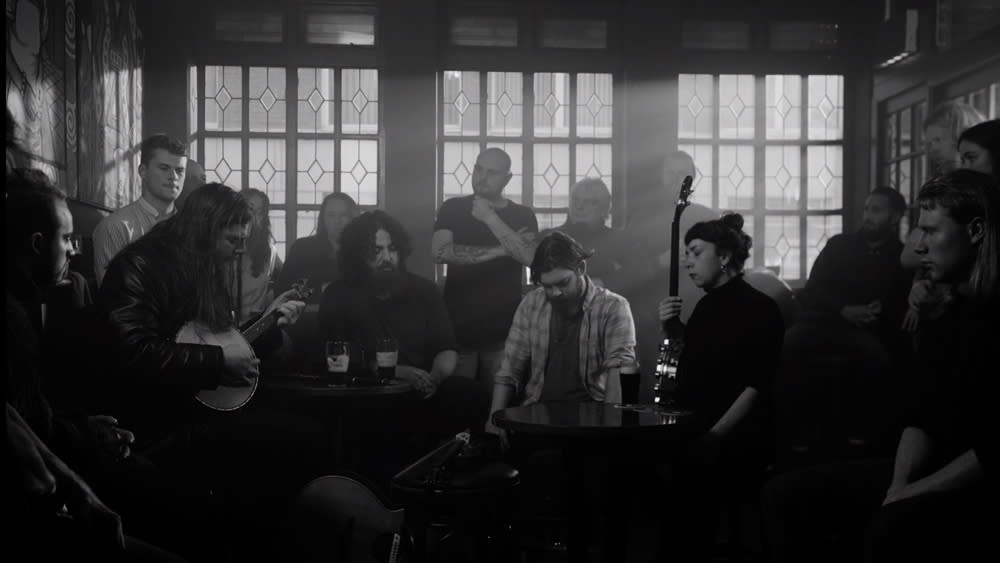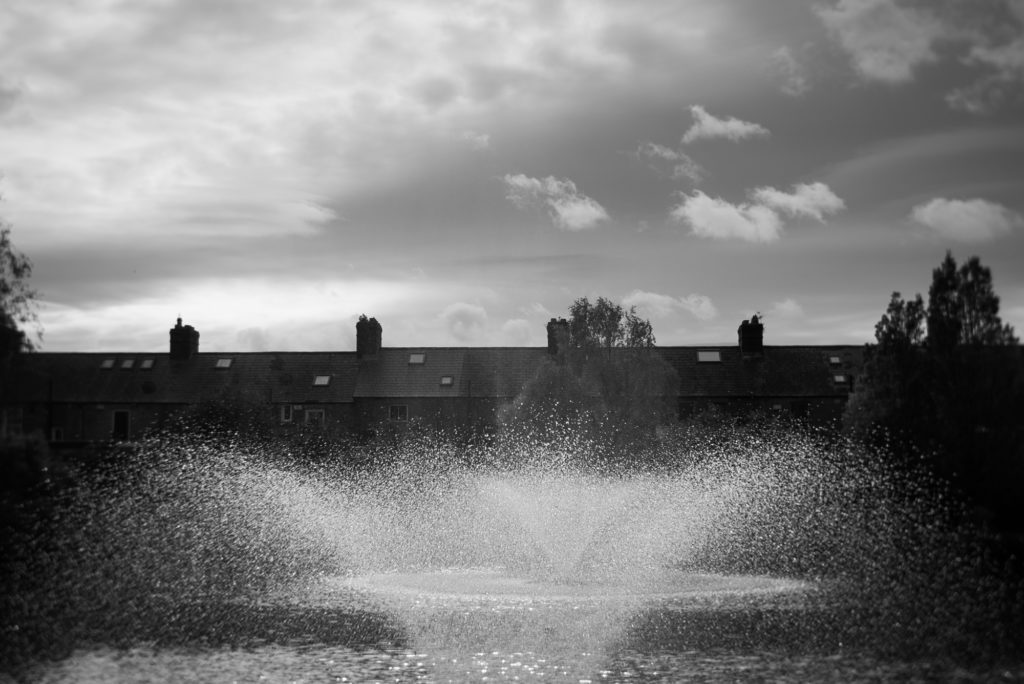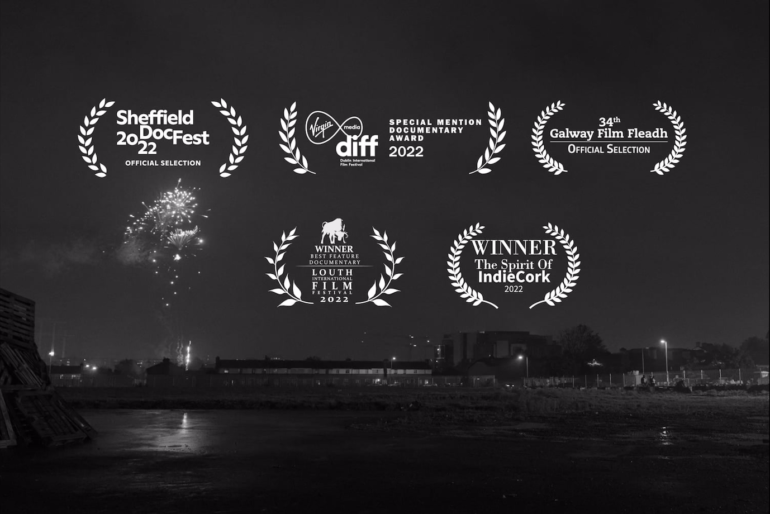As the Dublin feature doc North Circular goes on cinema release in Ireland and the UK, Lane Shipsey chats with director Luke McManus.
This music-filled feature documentary about the people and history of the area around Dublin’s North Circular road is well worth 84 minutes of your time. Harsh viewing at times, but also full of hope, with the sounds of traditional music recorded at the Cobblestone giving new voice to old narratives that rise up out of these stark black and white north Dublin streets.
Meeting director Luke McManus recently at IndieCork Film Festival offered the chance to ask what were the key factors in taking North Circular from dream to reality. ‘I actually had two separate things I wanted to do,’ he said. ‘One was to make a thing about the North Circular Road because I felt it connected all these significant places with huge weight and presence in the Irish imagination and my own imagination – stadiums and barracks and prisons and asylums, you know, all these kind of things. And then I also wanted to do something with some of the people from the Irish, from the new Dublin 7 folk scene, whatever you want to call it… So I had those two films that I wanted to make, but I hadn’t realised they were the same film.. Hah! So they were like two parallel processes in my brain that came together.’

Perhaps this explains North Circular’s depth of focus – it’s actually two films in one. Thanks to a slew of weighty collaborators too long to mention, the outcome is a crowd of human stories that come together in a rich monochrome cruise down the territory of the famous road. Starting at Phoenix Park with the barracks that were once central to the British army presence in the city, and taking in historical sites, among them some of Dublin’s most feared institutions, the film completes the road’s arc by heading down towards the docklands along Sheriff Street.
Along the way, it is the Dubliners sharing the road with us who really light up the film. The film’s strength is the voices, laughter and stories of people whose lives are here, whether ‘here’ means the army barracks, the now demolished O’Devaney Gardens flats, the Cobblestone, the Gorman (former mental hospital) or the Joy (Mountjoy prison). Many interesting characters are met, but for me the one who stands out is the tin whistler with his cup on the pavement and the memory of a pawned clarinet, joking that ‘the camera is in love with me’.
As McManus says, ‘The film then takes you through the series of neighbourhoods and you meet various people who tell you their stories. I didn’t want to just go, it can only be about the people who live in houses on the North Circular Road. So I started on this journey through neighbourhoods, and the Cobblestone’s a bit of a stretch, but you know the Cobblestone thing just happened to happen.’ He is referring here to the fight to prevent planning permission being granted for a hotel on the site of the Cobblestone pub, which along with Walshes of Stoneybatter is one of the main places where local people gather to play or listen to traditional music.
Director Luke McManus lives a stone’s throw from the North Circular. In planning and making this film, this was a huge asset — especially in 2020-2021, as it meant he would be able to work within lockdown restrictions. It also made the shoot affordable, green, and fairly agile. Some shoots were quickly set up in response to word spreading of a local event. ‘The protesters standing on the roof of the squatted building, that was just me at home one evening and the phone pinging, and me going you know what I should go down and check that out.’ Being local, he could set up while things were still in progress.
The film was funded through the Arts Council’s ReelArt scheme which afforded a great deal of artistic control. Working throughout 2021 with a string of different cinematographers (six including himself), McManus gave some visual leeway while setting enough constraints to ensure the footage would cut together well. There’s a playfulness in individual scenes, especially those featuring wildlife, children or football fans, that is testimony to staying open to the nuances and fresh possibilities of each situation, each unit of time that is recorded for the film.
A funny thing about North Circular and time. ‘A few weeks ago,’ McManus says, ‘I got out of my house and did the walk, going from the monument to the Point Depot which is kind of the logical end of the journey, and it was pretty much bang on 85 minutes, which is the length of the film.’

The kaleidoscopic array of moods played out in the course of North Circular will be familiar to anyone who has lived on or near a major urban road and been subject to its tidal rushes and ebbs of activity, patterns that repeat themselves day and night, summer and winter, periodically clearing the area and then flooding it with people and traffic once more. Other doc filmmakers have been inspired by similar roads in their part of the world. When I raise this McManus speaks of the great respect he has for Zed Nelson’s The Street set on London’s Hoxton Street (2019) and Gianfranco Rosi’s Sacro GRA (2013) about life along the Grande Raccordo Anulare, the ring-road that circles Rome. Women cinematographers/directors, from quite early on, have made some exemplary street documentary films. Standout examples would be Helen Levitt’s East Manhattan doc In the Street (1948) and the ‘more or less a casual look at my neighbours’ that Agnès Varda filmed on Rue Daguerre in Paris, where she lived, Daguerréotypes (1975).
He also mentions When All is Ruin Once Again (2018), Keith Walsh’s documentary feature about west of Ireland motorway-building mayhem: ‘Just a beautiful film and I really took a lot from that, was inspired by that.’ Tensions between planners and local people are part of both films, though North Circular has a wider scope in attempting to also take in institutions of government. McManus also produced The Lonely Battle of Thomas Reid which addresses issues of consent between those who govern and are governed. These are films that arguably should be studied by anyone working in Irish government, planning or building.
The word ‘local’ is key. Because each of these films about roads charts the story of its own area and characters, the concept takes on new life in each new locality. Condensed into this particular film is a sense of beauty and terror, aggression and quiet enjoyment, of destruction and of lasting human links. These contrasts and tensions make North Circular a film viewers from outside Dublin can ‘get’, as evidenced by awards received from Louth International Film Festival and the IndieCork Film Festival, and the fact the film has secured international distribution. Happily in the case of the Cobblestone a positive outcome arrives: after the sizeable demos shown in the film, planning permission is refused for the hotel that threatened to destroy this lynchpin of the local music scene. This is one of several reasons why North Circular ends on a positive note. Highly recommended.
North Circular is out now at local cinemas in Ireland and the UK.

